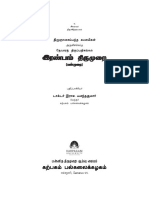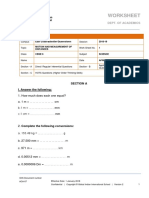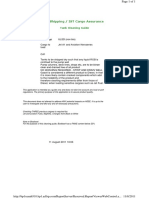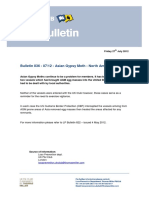Pumice Is Extrusive Rock and Form Outside of The Volcano Usually On Top of
Pumice Is Extrusive Rock and Form Outside of The Volcano Usually On Top of
Uploaded by
Jayakumar SankaranCopyright:
Available Formats
Pumice Is Extrusive Rock and Form Outside of The Volcano Usually On Top of
Pumice Is Extrusive Rock and Form Outside of The Volcano Usually On Top of
Uploaded by
Jayakumar SankaranOriginal Description:
Original Title
Copyright
Available Formats
Share this document
Did you find this document useful?
Is this content inappropriate?
Copyright:
Available Formats
Pumice Is Extrusive Rock and Form Outside of The Volcano Usually On Top of
Pumice Is Extrusive Rock and Form Outside of The Volcano Usually On Top of
Uploaded by
Jayakumar SankaranCopyright:
Available Formats
The Earth – Rocks and Soils
1. Make a list of five different ways that rocks can be used.
Making Cement (Limestone) (Sedimentary Origin)
Fire (Coal) (Sedimentary Origin)
Writing (Chalk) (Sedimentary Origin)
Building Material (Sandstone) (Sedimentary Origin)
Bath Scrub (Pumice) (Igneous Origin)
Kerb Stone (Granite) (Igneous Origin)
Roofing Material (Slate) (Metamorphic Origin)
Statue/Ornaments/Decoration (Marble) (Metamorphic Origin)
Valuable source of minerals (Gold, Diamond, Sapphire e.t.c)
Some rocks acts as tourist attraction sites.
2. Which rock is most likely to contain oil or gas? Why?
The types of rocks that contain oil and natural gas are all sedimentary rocks.
Because, these rocks formed when grains and mineral particles deposited by
running water fuse together. Because these rocks are cemented together from
such small components, they are porous, full of spaces in which energy-rich
carbon compounds can settle, later to be liberated in the form of either oil or gas.
3. Look at the figure 6.9. Would you expect rocks with small crystals to form at A, B or
C?
It is at A, because magma that cools slowly will form an igneous rock with large crystals
and lava that cools quickly will form an igneous rock with small crystals.
4. Would you expect rocks with large crystals to form at A,B or C?
Large crystals will for at C, lower the magma, the cooling and solidification takes longer
and the crystals become larger.
5. Explain why granite has large crystals and basalt has small crystals.
If the rock cools slowly, there is plenty of time for a large grid pattern to form. This
makes large crystals. Granite forms from the slow crystallization of magma below
Earth's surface. Hence it has large crystals.
If the rock cools down quickly, there is much less time for the particles to become
ordered and so smaller crystals are made. Basalt is an extrusive igneous rock that
forms when lava reaches the Earth's surface at a volcano and crystallizes fast.
6. What properties does pumice have, that make it different from other igneous rocks?
Pumice is lighter and less denser. It is fine grained and highly porous.
7. Why do you think the rock has holes in it?
Pumice is extrusive rock and form outside of the volcano usually on top of
lava flows. The top of these lava flows become very frothy and when they cool
the gasses in the lava expand and escape forming air hole or vesicles in rock.
8. The layers of sandstone at uluru (figure 6.15) contain many fossils of sea animals. How
did these fossils get to the middle of Australia?
Fossils are generally found in Sedimentary rocks. Uluru is composed mainly of layer
after layer of a type of coarse sandstone known as arkose. Due to tectonic activity 500
million years ago, the land mass of Australia gets separated from the rest of the world.
9. Could marble contain fossils? Why?
Marbles are metamorphic rocks. Fossils rarely occur in metamorphic rocks. The heat
and pressure required to change, or metamorphose, rocks usually destroys any fossils.
10. Describe how igneous rocks are changed into metamorphic rocks.
All rock can be heated. Inside Earth there is heat from pressure that
bakes the rock. Baked rock does not melt, but it does change. It
forms crystals. If it has crystals already, it forms larger crystals.
Because this rock changes, it is called metamorphic. When massive
amounts of heat and pressure are applied to an igneous rock or sedimentary
rock, it compacts and becomes a metamorphic rock.
You might also like
- Natesha Kautuvam LyricsDocument6 pagesNatesha Kautuvam LyricsJayakumar Sankaran56% (9)
- The Conoco Weather ClauseDocument10 pagesThe Conoco Weather ClauseJayakumar SankaranNo ratings yet
- Natesha Kauthuvam LyricsDocument2 pagesNatesha Kauthuvam LyricsJayakumar Sankaran67% (6)
- IIT JAM Geology: Preparation Tips, Books, Study Materials!Document13 pagesIIT JAM Geology: Preparation Tips, Books, Study Materials!Kadamb Sachdeva100% (1)
- WORLDSCALEDocument24 pagesWORLDSCALEJayakumar SankaranNo ratings yet
- Metamorphic, Igneous and Sedimentary Rocks : Sorting Them Out - Geology for Kids | Children's Earth Sciences BooksFrom EverandMetamorphic, Igneous and Sedimentary Rocks : Sorting Them Out - Geology for Kids | Children's Earth Sciences BooksNo ratings yet
- Rocks and Minerals WebquestDocument2 pagesRocks and Minerals Webquestapi-26409999247% (15)
- ASTM TablesDocument185 pagesASTM TablesJayakumar Sankaran50% (4)
- Rocks - Teachers NotesDocument5 pagesRocks - Teachers NotesSaman AkramNo ratings yet
- sw7 3ed chp11Document38 pagessw7 3ed chp11api-115560904No ratings yet
- Assignment 4Document2 pagesAssignment 4Prince BalmojaNo ratings yet
- Class 9 Chapter 6 RocksDocument10 pagesClass 9 Chapter 6 Rocksdasguptaj4No ratings yet
- Inside The EarthDocument3 pagesInside The EarthNawal Bint SaleemNo ratings yet
- 06 MineralsDocument6 pages06 MineralsASLAN LESSONSNo ratings yet
- Types of Rocks: Rock Stars: Igneous, Sedimentary and MetamorphicDocument3 pagesTypes of Rocks: Rock Stars: Igneous, Sedimentary and MetamorphicLara ZainNo ratings yet
- Rock and Minerals WorksheetDocument2 pagesRock and Minerals WorksheetReynand Fenolan Dumala-onNo ratings yet
- Chapter 3.1 - Igneous RockDocument64 pagesChapter 3.1 - Igneous Rockalvinllp83No ratings yet
- Rock Summary Worksheet Key 2gea3mwDocument3 pagesRock Summary Worksheet Key 2gea3mwRuvimar Diciano MabborangNo ratings yet
- gr6 Rocks and The Rock CycleDocument4 pagesgr6 Rocks and The Rock Cyclemai sasaNo ratings yet
- The Rock CycleDocument3 pagesThe Rock CycleRODJHEN ANNE P. BARQUILLANo ratings yet
- Rock LabDocument5 pagesRock LabsercarlosNo ratings yet
- 8H The Rock CycleDocument11 pages8H The Rock CyclejeethaNo ratings yet
- Gess 202Document5 pagesGess 202Kalpavriksha1974100% (1)
- W3M1 - Igneous RocksDocument39 pagesW3M1 - Igneous Rocksaxieinvestment550No ratings yet
- Inside Our Earth Questions and AnswersDocument4 pagesInside Our Earth Questions and AnswersKalai Selvi MohanNo ratings yet
- KS3 Year 7 Science Independent Learning Booklets Earths StructureDocument13 pagesKS3 Year 7 Science Independent Learning Booklets Earths StructureFelissa AxtonNo ratings yet
- PlanetaryGeology BackgroundMaterial PDFDocument64 pagesPlanetaryGeology BackgroundMaterial PDFMikko Delos ReyesNo ratings yet
- The Types of RockDocument13 pagesThe Types of RockrhodtenauNo ratings yet
- Engineering GeologyDocument117 pagesEngineering GeologyJoshua Mong'areNo ratings yet
- Types of RocksDocument11 pagesTypes of Rockssdgupta76No ratings yet
- Unit 8 - Answers To Courseboook QuestionsDocument1 pageUnit 8 - Answers To Courseboook QuestionsDeeyana Areef ChowdhuryNo ratings yet
- Rocks and Minerals Webquest 3Document4 pagesRocks and Minerals Webquest 3api-264090670No ratings yet
- Cabuyao Institute of Technology: Core 4 - Earth Science 3 Types of RocksDocument11 pagesCabuyao Institute of Technology: Core 4 - Earth Science 3 Types of RocksJulius Michael DicheNo ratings yet
- Chapter 4 Rocks and MineralsDocument92 pagesChapter 4 Rocks and MineralsYogendra PatilNo ratings yet
- The Three Types of RocksDocument12 pagesThe Three Types of RocksClemencia Eduria MasibaNo ratings yet
- ROCKSDocument12 pagesROCKSAce ManicaoNo ratings yet
- Rocks and What We Know About Them - Geology for Kids | Children's Earth Sciences BooksFrom EverandRocks and What We Know About Them - Geology for Kids | Children's Earth Sciences BooksNo ratings yet
- Outlines of The PresentationDocument48 pagesOutlines of The PresentationSATYAM BHARTINo ratings yet
- Rock FormationDocument24 pagesRock Formationsashana puseyNo ratings yet
- Earth Sciences Notes Csir-Ugc Net JRFDocument57 pagesEarth Sciences Notes Csir-Ugc Net JRFmanas773No ratings yet
- Classification of RocksDocument18 pagesClassification of RocksStrng PndNo ratings yet
- Geography Chapter 2Document4 pagesGeography Chapter 2t6003228984No ratings yet
- About Igneous RockDocument14 pagesAbout Igneous RockThia BummiesNo ratings yet
- GRNČARSTVO Nekoliko Knjiga GtzaDocument417 pagesGRNČARSTVO Nekoliko Knjiga GtzaMilan ĐurićNo ratings yet
- Geo ResearchDocument17 pagesGeo Researchdylas0079No ratings yet
- All About Types of RocksDocument5 pagesAll About Types of Rockspancit cantonNo ratings yet
- 4 Grade Earth Science Review: By: Mr. Castellanos @ford BLVD ElementaryDocument37 pages4 Grade Earth Science Review: By: Mr. Castellanos @ford BLVD Elementaryhpc9354No ratings yet
- Rocks, Weathering and Landforms o LevelDocument16 pagesRocks, Weathering and Landforms o LevelmanisinkomoNo ratings yet
- Rocks and Minerals Webquest 1Document3 pagesRocks and Minerals Webquest 1api-265487375No ratings yet
- Introduction To Igneous Rocks - ResourceDocument3 pagesIntroduction To Igneous Rocks - ResourceLouie CarreonNo ratings yet
- Cambridge Secondary One Science: Chapter 8: The EarthDocument40 pagesCambridge Secondary One Science: Chapter 8: The EarthEric ChewNo ratings yet
- The Rock CycleDocument6 pagesThe Rock CycleAnonymous s6MgSsH9eNo ratings yet
- Heriot-Watt Geoscience Exam Learning Objectives With AnswersDocument11 pagesHeriot-Watt Geoscience Exam Learning Objectives With AnswersAkhundova FirangizNo ratings yet
- Rock Worksheet PDFDocument2 pagesRock Worksheet PDFLara ZainNo ratings yet
- Rock WorksheetDocument2 pagesRock WorksheetCristina MaquintoNo ratings yet
- Rock Worksheet PDFDocument2 pagesRock Worksheet PDFsunithaNo ratings yet
- Weathering and Erosion BookletDocument16 pagesWeathering and Erosion BookletnoahNo ratings yet
- Chapter 2 Inside Our EarthDocument6 pagesChapter 2 Inside Our EarthGaming ApocalypseNo ratings yet
- Rocka With ExamplesDocument6 pagesRocka With ExamplesAr Deepti ManojNo ratings yet
- Types of Rocks and Minerals-1Document10 pagesTypes of Rocks and Minerals-1Vitalis KinyuaNo ratings yet
- Earth Science: Quarter 2 - Module 9: How Layers of Rocks (Stratified Rocks) Are FormedDocument9 pagesEarth Science: Quarter 2 - Module 9: How Layers of Rocks (Stratified Rocks) Are FormedMelody LagunaNo ratings yet
- Geography CSS and PMS Chapter 1 and 2Document25 pagesGeography CSS and PMS Chapter 1 and 2Ismail BarakzaiNo ratings yet
- Rocks and GeologyDocument7 pagesRocks and GeologySealane TrayaNo ratings yet
- Classifications of RocksDocument1 pageClassifications of RocksGLENN MENDOZANo ratings yet
- Chugoku Marine Paints CMP Coating Resistance LIst Mar18Document601 pagesChugoku Marine Paints CMP Coating Resistance LIst Mar18Jayakumar Sankaran0% (1)
- List of Common Medical AbbreviationsDocument3 pagesList of Common Medical AbbreviationsJayakumar SankaranNo ratings yet
- Transcript of IB Chemistry Mind MapDocument8 pagesTranscript of IB Chemistry Mind MapJayakumar SankaranNo ratings yet
- Resistance List: Product Carrier Tank CoatingDocument121 pagesResistance List: Product Carrier Tank CoatingJayakumar SankaranNo ratings yet
- Energy notesSL and NumericalDocument51 pagesEnergy notesSL and NumericalJayakumar SankaranNo ratings yet
- IGCSE ICT - Chapter 2 PDFDocument9 pagesIGCSE ICT - Chapter 2 PDFJayakumar Sankaran100% (1)
- Technical Regulatory News No24 2016Document2 pagesTechnical Regulatory News No24 2016Jayakumar SankaranNo ratings yet
- 1.3.3 Input DevicesDocument20 pages1.3.3 Input DevicesJayakumar SankaranNo ratings yet
- Anchoring Guidelines Draft V7 Send To ISTECDocument39 pagesAnchoring Guidelines Draft V7 Send To ISTECJayakumar Sankaran100% (1)
- Calculus FormulasDocument384 pagesCalculus FormulasJayakumar SankaranNo ratings yet
- Blending Versus ComminglingDocument3 pagesBlending Versus ComminglingJayakumar SankaranNo ratings yet
- Kalam Wrote 12 Books in Total and He Was Also Fond of Writing Songs and PoetryDocument2 pagesKalam Wrote 12 Books in Total and He Was Also Fond of Writing Songs and PoetryJayakumar SankaranNo ratings yet
- Factors and MultiplesDocument10 pagesFactors and MultiplesJayakumar SankaranNo ratings yet
- WS CBSE6 Science MeasurementDocument7 pagesWS CBSE6 Science MeasurementJayakumar SankaranNo ratings yet
- BP Shipping / IST Cargo Assurance: Tank Cleaning GuideDocument1 pageBP Shipping / IST Cargo Assurance: Tank Cleaning GuideJayakumar SankaranNo ratings yet
- The Seafaring DictionaryDocument399 pagesThe Seafaring DictionarySerdar Kontaş100% (4)
- Bulletin 836Document1 pageBulletin 836Jayakumar SankaranNo ratings yet
- RVP Related ArticleDocument31 pagesRVP Related ArticleJayakumar SankaranNo ratings yet
- Geomorphic Processes: Exogenous Endogenous ProcessesDocument17 pagesGeomorphic Processes: Exogenous Endogenous ProcessesCatalinus SecundusNo ratings yet
- Earthquakes: MembersDocument17 pagesEarthquakes: MembersTevin SamuelsNo ratings yet
- A Powerpoint Presentation On: Recording Features of Sedimentary RocksDocument42 pagesA Powerpoint Presentation On: Recording Features of Sedimentary RocksJamalNo ratings yet
- BLTN11184 6431880 01Document35 pagesBLTN11184 6431880 01جمال سلطانNo ratings yet
- The Beauty and Danger of A Volcano by ChiongDocument3 pagesThe Beauty and Danger of A Volcano by ChiongCHIONG, ABEGAIL, T.No ratings yet
- Geology BSC Syllabus 2017 18 OnwardsDocument31 pagesGeology BSC Syllabus 2017 18 OnwardsManali SawantNo ratings yet
- Educational Field Trip ReportDocument25 pagesEducational Field Trip Reportaakuma100% (2)
- SD LabDocument18 pagesSD LabMargono ThokNo ratings yet
- River & Stream Systems Erosion Hazard LimitDocument134 pagesRiver & Stream Systems Erosion Hazard Limitblasticinc100% (1)
- Geophysics Report AshegodaDocument34 pagesGeophysics Report AshegodaGechmcz100% (1)
- The Rock CycleDocument28 pagesThe Rock Cycleapi-263638354No ratings yet
- Geology of Rajasthan PDFDocument140 pagesGeology of Rajasthan PDFGirijesh Pandey100% (1)
- Plate Tectonics-WPS OfficeDocument21 pagesPlate Tectonics-WPS OfficeAila Jane Olano VestidasNo ratings yet
- Exogenic and Endogenic ProcessesDocument22 pagesExogenic and Endogenic ProcessesFaith OdeñaNo ratings yet
- River Engineering NotesDocument6 pagesRiver Engineering NotesAkib KhanNo ratings yet
- 4-Types of Plate BoundariesDocument54 pages4-Types of Plate BoundariesImee TiloNo ratings yet
- Basic Terminology in Structural GeologyDocument4 pagesBasic Terminology in Structural GeologymehrozhassanNo ratings yet
- Earthquake Resistant Steel StructuresDocument128 pagesEarthquake Resistant Steel StructuresJack AndreNo ratings yet
- Porphyry DepositsDocument44 pagesPorphyry DepositsChristianNo ratings yet
- Watershed MorphologyDocument29 pagesWatershed Morphologyerashwanisoni2095No ratings yet
- Resource Evaluation Week 4Document87 pagesResource Evaluation Week 4Mon RonquilloNo ratings yet
- Beukes and Gutzmer. 2008. Origin and Paleoenvironmental Significance of Major Iron Formations at The Archean-Paleoproterozoic BoundaryDocument43 pagesBeukes and Gutzmer. 2008. Origin and Paleoenvironmental Significance of Major Iron Formations at The Archean-Paleoproterozoic BoundaryAndzani Ndhukwani100% (1)
- QuizDocument6 pagesQuizRenzo AlvizNo ratings yet
- Ex06 - Research Methods Report - GISN27 - Kaleab WoldemariamDocument14 pagesEx06 - Research Methods Report - GISN27 - Kaleab WoldemariamKaleab WoldemariamNo ratings yet
- Lithology, Structure and Geomorphology of The Nagari Outliers, Chittoor District, Andhra Pradesh, IndiaDocument8 pagesLithology, Structure and Geomorphology of The Nagari Outliers, Chittoor District, Andhra Pradesh, IndiaIOSRjournalNo ratings yet
- Dr. Gamal Ragab Gaafar Resume Updated November 2019Document25 pagesDr. Gamal Ragab Gaafar Resume Updated November 2019Dr. Gamal Ragab GaafarNo ratings yet
- Popular Prospecting 1955Document81 pagesPopular Prospecting 1955Andrew Simpson100% (1)
- Engineering Geology: An Environmental ApproachDocument9 pagesEngineering Geology: An Environmental ApproachMarcus Paulo SaúdeNo ratings yet
- Characterization Pressure and Temperature InfluencDocument15 pagesCharacterization Pressure and Temperature Influencjhon berez223344No ratings yet
















































































































